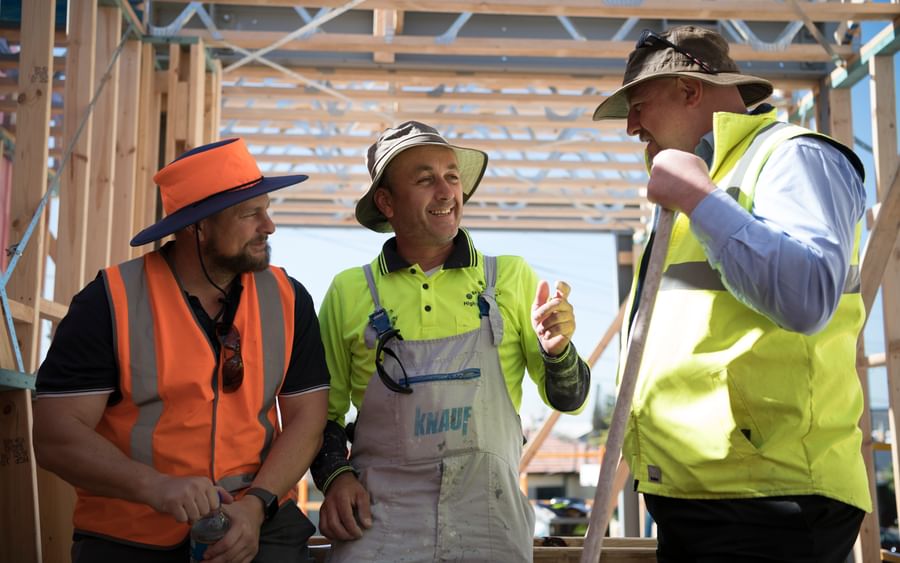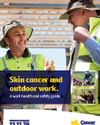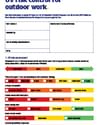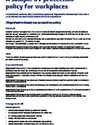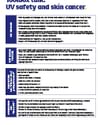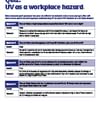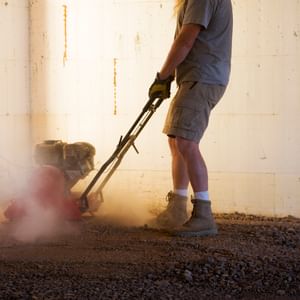UV protection in the workplace
Did you know the workplace is one of the main places where Australians are exposed to UV radiation?
For people who work outdoors, this can mean being exposed to up to ten times more UV than those who work indoors.
The effects of UV exposure are cumulative – the more you’re exposed to over your lifetime, the higher your risk of developing skin cancer. This means outdoor workers are at a higher risk of developing skin cancer, and that risk grows and grows with time.
Employers have a legal obligation under Australian work health and safety laws, to protect workers from overexposure to UV radiation. Putting strong sun protection measures in place at work can help prevent UV-related harm and reduce the impact of skin cancer. In addition to reducing the toll it can take on worker’s health, productivity, morale and business costs.
Support to make your workplace SunSmart
Cancer Council SA can support your workplace in identifying UV exposure risks to workers and assist you in developing practical strategies to manage and reduce them.
We help workplaces meet their WHS responsibilities and duty of care by providing:
- a range of resources
- education sessions for workers
- help with reviewing or developing a sun protection policy.
The goal is to support a whole of organisation approach by giving workplaces the chance to build their knowledge, assess risks in their specific context and review current practices.
Get involved
To learn more about our SunSmart Workplaces services, access resources or organise an education session for your workplace, get in touch with us!
Elysia Flavel, Prevention Programs Lead
T: 08 8291 4118
E: prevention@cancersa.org.au
SunSmart tips to reduce UV exposure at work
Being SunSmart in the workplace is a shared responsibility. Here are a few key things you can do to get started with implementing UV protection in the workplace:
- Get everyone on board. Organisation-wide support, from management and workers, is crucial.
- Communicate clearly and consult with the team such as surveys, toolbox talks or stakeholder updates.
- Use existing meetings, like WHS committees, to talk about UV, or form a working group to address it.
- Make it part of WHS policies or procedures.
- Give people time to adapt to changes.
- Remind people about the policies, and their legal obligations to work safely under the WHS act.
Step 1 – Understand the risk
In order to protect your workplace from the risks of UV, you need to not only understand the prevention strategies themselves, but also why it is so important.
Why UV is a workplace hazard
We have a legal obligation to manage hazards in the workplace — and UV harm is no exception:
- UV radiation is a class 1 carcinogen, like asbestos and tobacco, and is responsible for the vast majority of skin cancers in Australia. Many people aren’t aware it’s in the same risk category.
- Outdoor workers are exposed to UV every time they’re outside during daylight hours, regardless of the weather. This exposure builds up over time, increasing the risk of skin cancer. Even small, repeated doses can cause damage to unprotected skin and eyes.
- Under WHS legislation, it’s your responsibility to manage hazards and protect workers from harm, including UV overexposure.
Why outdoor workers need year-round sun protection
Even a little sun exposure is dangerous over a long enough time:
- UV damage to skin and eyes is cumulative, meaning it adds up over time, even on days when the UV index is low.
- It’s not just about how strong the UV is; it’s also how long you’re exposed, how often and the pattern of exposure. Even short periods in and out of the sun across the day can add up to a high total UV dose.
- Sun protection helps prevent long-term skin damage and reduces the risk of skin cancer. If you or your team work outdoors, using sun protection daily is essential, no matter the season or the UV rating.
What does ‘reasonably practicable’ UV protection look like at work?
This will depend on your own circumstances. The higher the risk, the higher the expectation of what would be considered ‘reasonable’ protection.
Under the WHS Act, businesses and employers (PCBUs) have a duty to protect workers from health and safety risks – including UV exposure. This means identifying the hazard, assessing the risks and putting control measures in place that are considered reasonably practicable.
To decide what’s reasonable, you should consider:
- how likely UV exposure is: outdoor workers face much higher UV exposure than indoor workers (up to 10 times more)
- how harmful it can be: UV radiation causes skin cancer, including melanoma, and every year around 2,000 Australians die from skin cancer
- what’s known about the risk and how to manage it: sun protection programs that include shade, protective gear, sunscreen, and worker education are effective ways to reduce risk
- what options are available and suitable: adjusting work hours, using portable shade, rotating tasks, providing PPE (sun protective clothing, hats and sunglasses) and sunscreen, and encouraging self-skin checks are all proven strategies
- cost vs. benefits: the cost of prevention is often far less than the cost of skin cancer, lost productivity, or legal liability.
While every workplace is different, decisions should be made in consultation with workers and backed by a proper risk assessment. Workers also have a role to play by following safety procedures and looking after their own health.
Whether you’re self-employed or managing a team, investing in sun protection is a smart move — for your people and your business alike.
Step 2 – Assess and manage the UV risks
Regular UV risk assessments help determine how much risk your workers face and what should be done to reduce it. Use the hierarchy of controls to identify practical ways to eliminate or minimise exposure as much as reasonably practicable.
When conducting a UV risk assessment, consider:
- which workers are exposed: not just who, but when and where. Look at times of day, time of year, tasks, locations and the number of people affected.
- environmental factors: such as reflective surfaces, and lack of shade that could increase UV exposure.
- current control measures: review what’s already in place (e.g. uniforms, hats, sunscreen, eye protection) and whether they are effective and sufficient.
- individual photosensitivity: some individuals are especially sensitive to UV and may need additional support – photosensitivity can be triggered by certain chemicals, plants or medications. Learn more at Safe Work Australia.
Step 3 – Document it
Having a UV or sun protection policy is a smart way to record how your workplace manages UV risks. This can be a new policy, procedure or an update to existing WHS documentation.
Your documentation should outline:
- the UV hazard and why it’s a priority
- what control measures are in place
- training and education requirements
- who is responsible for implementation and monitoring
- how to report UV-related injuries or non-compliance
- how and when the policy will be reviewed.
Step 4 – Communication is key
Educating and informing workers helps build a positive safety culture and improves compliance. Regularly explain why UV measures are in place and keep the conversation going.
Ways to communicate include:
- posters and printed materials: use visual prompts and take-home resources
- verbal reminder: reinforce sun safety during meetings and on the job
- PPE guidance: show workers what’s available, how to use it, ask for feedback on comfort and suitability
- supervision and role modelling: lead by example and ensure compliance is part of everyday practice
- self-check reminders: encourage workers to check their own skin regularly and consider flexible work arrangements to allow for professional screenings with a doctor or specialist.
Step 5 – Implementing control measures
A combination of control measures can be implemented to manage risks by reducing time spent in the sun and protecting workers from harmful UV exposure.
Measures to consider:
- Elimination: Move tasks indoors or rotate jobs to limit an individual worker’s time spent outdoors.
- Engineering controls: Provide permanent or portable shade, reduce reflective surfaces and install window tinting to vehicles and machinery.
- Administrative controls: Schedule outdoor work during lower UV level times (early in the morning or later in the afternoon), provide training, display the UV index and promote early detection.
- Personal protective equipment (PPE): ensure workers understand how to protect their skin, and have access to:
- sun protective work clothing – long-sleeved shirts with collars, long pants, and high UPF fabrics
- sun protective hats – broad-brimmed hats that shade the head, face, ears and neck; or brim attachments where helmets or hard hats are a requirement
- sunglasses – close-fitting, wraparound sunglasses that meet Australian Standards (AS/NZS 1067) or safety glasses marked with an ‘O’ for outdoor use
- sunscreen – SPF 50 or 50+, broad-spectrum, water-resistant sunscreen reapplied at least every two hours.
Remember, no single control is enough. Combine multiple strategies for maximum protection. Learn more about how to protect your skin.
Step 6 – Monitor, review and improve
Being SunSmart is an ongoing responsibility. Even once measures are in place, it is crucial to proactively review effectiveness, and check whether workers are following them.
Review activities might include:
- getting feedback: asking your team what’s working and what’s not
- reassessing: repeating your UV risk assessment
- checking in: checking compliance and behaviour change
- monitoring awareness: surveying workers on their attitudes and understanding of UV safety.
Apply what you learn to improve your approach and strengthen sun safety across your workplace.
SunSmart Workplace Online Learning
Our online learning videos are a self-paced learning resource so that you can click on each module of interest and stop and start at any time.
